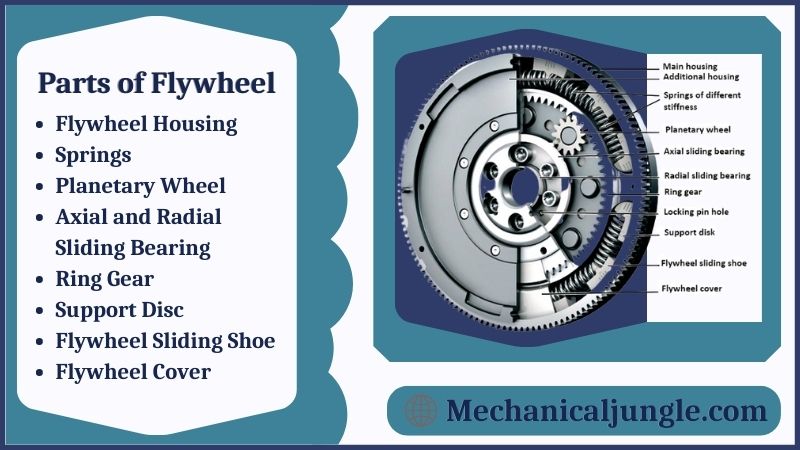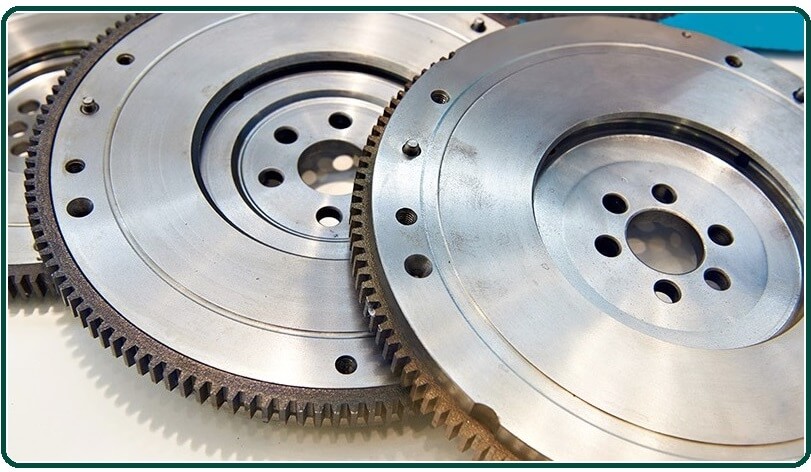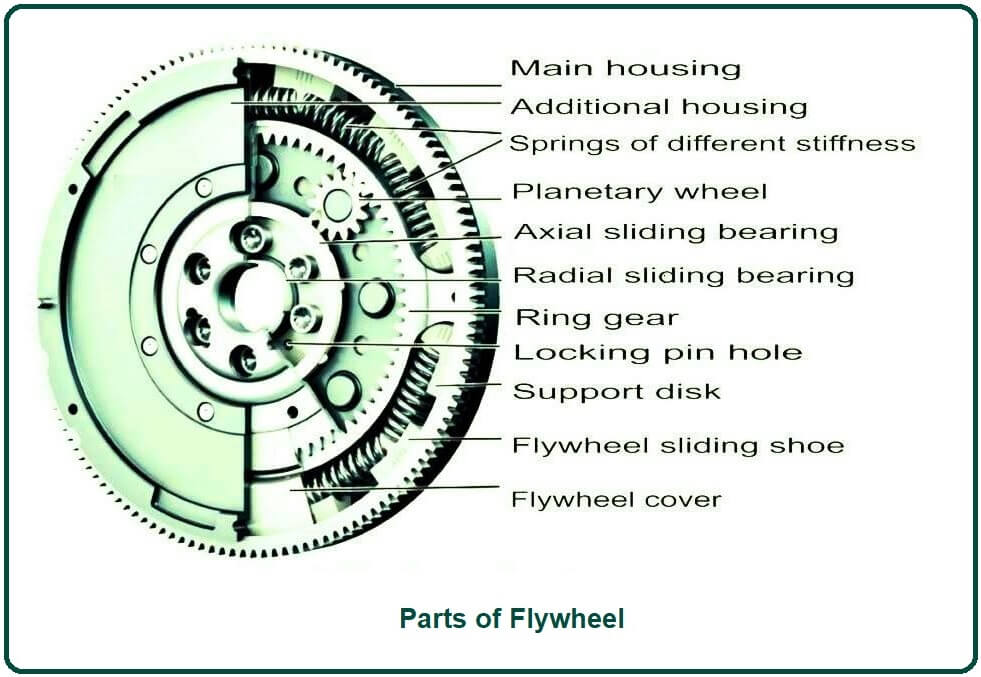
What Is a Flywheel?

As a heavy wheel, a flywheel needs sufficient force to rotate on its axis. It opposes the change in rotational speed from its moment of inertia. Changing the energy stored on the Flywheel, its rotational speed must be increased or decreased.
That is, it keeps spinning until a lot of force is applied. A large amount of kinetic energy is conserved when the Flywheel is spinning.
This energy is later used to start the engine or drive the vehicle at high speed. Today we will look at the definition, construction, function, working principle, and symptoms of a bad automobile flywheel.
Functions of Flywheel:
The Flywheel can be found in almost all types of automobiles as they serve different purposes, which will be discussed here. The functions of a flywheel in an automobile engine are given below:
#1. Engine Balance
Because the piston is offset from the center of crankshaft vibration and wobble, this is also because each piston fires at a different angle.
The function of the Flywheel in this situation is to suppress the side-to-side motion. This is achieved due to the heavyweight of the Flywheel. The Flywheel reduces vibrations throughout the engine as the engine is stable and balances on the mounts.
#2. Engine Start
The Flywheel plays another role when starting the engine. The gear teeth on the Flywheel are connected to the starter motor.
This starter motor is controlled by the car key, so when the car starts, the starter motor spins the Flywheel. Immediately the engine spins, the combustion effect keeps the engine running. The Flywheel retracts the Bendix gear in the started motor to rotate freely.
#3. Drivetrain Stress Reduction
Another function of a flywheel is achieved by stabilizing engine speed. It also smooths engine speed and reduces wear and tear on drivetrain components. The Flywheel also limits the wear between the transmission shaft and the driveshaft. These two are connected by a universal joint.
#4. Engine Speed Soothing
The crankshaft converts piston movement into rotary motion, which is jerky when power is generated. The rotational speed of the crankshaft is constants, & the engine runs smoothly.
This is because the mass of the Flywheels applies inertia that keeps the engine crankshaft rotating between each piston firing.
#5. Weight Manipulation
The weight of the Flywheel determines engine performance. The weight is designed based on the performance of the vehicles. The heavy Flywheel allows the engine to operate under loads that can cause engine failure.
A larger truck or trailer does well with a heavy flywheel, while sports cars and some commercial cars make good use of a lighter flywheel.
Types of Flywheel:
#1. Solid Disc Flywheel
A solid disc flywheel is a kind of Flywheel. It is used in singles flywheel thresher, which is made of cast iron. Solid Disc Flywheel The Flywheel is equipped with a hub and disc.
In the design calculations of a solid disc flywheel, various parameters are used as inputs. This includes the dimensions of the Solid Disc Flywheel. In addition, the resulting functional values are calculated.
#2. Rimmed Flywheel
A rim-type wheel will detonate at a much lower rotary speed than a solid disc-type wheel of the same weight & diameter. For minimal weight and high energy-storage capacity, flywheels can be made from high-strength steel and produced as a tapered disc, which is thicker in the center.
#3. High-Velocity Flywheel
In this type of Flywheel, the high-velocity Flywheel has a velocity between 30000 rpm to 80000 rpm. It can also be adjusted up to 100,000 rpm.
They have magnetic levitation bearings & require little maintenance. In terms of size/capacity, they are lighter in weight than low-velocity flywheels. They are more expensive than low-velocity flywheels.
#4. Low-Velocity Flywheel
In this type of Flywheel, the low-velocity Flywheel has a velocity of 10000 rpm. They are heavier and heavier than the high-velocity Flywheel. They require periodic maintenance and do not use magnetic levitation bearings.
Their installation requires special concrete construction to bear its own weight. They are more economical than high-velocity flywheels.
Common Problems of Flywheel:
#1. Clutch Dragging
In this case, the clutches will not release completely. These will cause different levels of gear grinding when changing gears.
Also, when it starts to a standstill, the car may completely fail to put it in first gear. This problem occurs not only in the Flywheel but also in the bearing or bushing of the Flywheel or crankshaft assembly.
#2. Clutch slipping
This problem occurs when the gear changes automatically while driving. This can cause the gear to slip. This happens when power are not transferred to the wheel, resulting in clutch failure.
A slipping clutch will eventually deform the Flywheel as well. The pressure plate can cause a sudden grinding sound. The other parts of flywheels in the clutches assembly will heat up. These will lead to bends and even cracks.
#3. Burning smell
When the clutch wears out, a burning smell will arise. It is caused by a faulty flywheel or unskilled operators.
The face of the clutches is designed with the proposed materials to reduce the amount of sound the clutch makes while operating. It produces a lot of heat due to friction when the facing is not operated properly.
#4. Clutch Chatter
This is when the clutch has difficulty engaging. As the clutch takes hold, it slips along with the Flywheel and repeatedly releases the Flywheel. It sounds like a stutter or vibration when released.
Clutch chatter often occurs in any gear when starting with a full stop. This fault can be difficult to identify because there is a defect in the clutch disc, pressure plate, or release bearing. These parts can also be broken, deformed, or contaminated with oil.
#5. Clutch Pedal Vibration
You may have noticed that the clutches pedal or the vehicle floor vibrates when the Flywheel is damaged. This is because the spring mount of the Flywheel has declined. Let us tell you that the spring mechanisms reduce the vibration caused by the clutches being used.
Parts of Flywheel:

#1. Flywheel Housing
The flywheel housing is solid and sits on the outside of the Flywheel. The flywheels are the part of the engine that spins and provides power to the alternator.
#2. Springs
The Flywheel is composed of two-stage bent springs in parallel. The external arc is adjusted to raise the spring when the engine is running. The soft outers arc spring only serves to rectify the indefinite resonant frequency range.
#3. Planetary Wheel
A planetary wheel consists of several planetary gears fixed on a flywheel bracket. When the flywheel bracket is driven by a screw and rotates, each planetary gear meshing with the outer ring gear generates a compound motion composed of revolutions and rotations.
#4. Axial and Radial Sliding Bearing
Whereas an axially acting bearing serves only for weight compensation, imbalance or parasitic radial forces introduced by the motor or generator unit must be compensated.
Radial Bearings.
#5. Ring Gear
A ring gear is mounted in the outer diameter of the Flywheel. It is usually attached to the Flywheel by means of an interference fit, which is prepared by heating the ring gear. So, thermal expansion enables it to be placed around the Flywheel.
#6. Support Disc
As the name suggests, support discs are attached to the inside of the Flywheel to support the two-stage bent springs and other components of the Flywheel.
#7. Flywheel Sliding Shoe
Sliding shoes preferably have a convex radial exterior that is on the inner wall of the flywheels. In these areas, they are preferably manufactured to promotes slip and withstand the least amount of wear and tear.
#8. Flywheel Cover
The flywheel cover is usually made of chrome. These chrome-plated flywheel covers will prevent dust from getting into the inner workings of the Flywheel, causing it to run poorly.
Working Principle:
The working principle of the Flywheel is quite simple and interesting as it stores the energy for the use of the vehicle. Just as a mechanical battery stores energy in chemical form, the Flywheel saves power in the form of kinetic energy.
The more energy is produced, the more speed the Flywheel spins. It has a high moment of inertia which means heavy. It is better to spin faster than to increase its mass. This is because a lighter wheel generates twice as much energy as a flywheel that is more or twice as heavy.
That is, the lighter the Flywheel; the more energy is stored. It is advisable to use light, high-speed wheels instead of wheels with a large weight.
But heavy vehicles will be suitable for heavy vehicles like trailers, trucks, vans, etc. This is because they carry extra weight and are not important for running at high speeds.
So, knowing how a flywheel works, the higher the speed, the higher the energy. However, if the speed continues to increase, the wheel may not be able to handle the material force. This can lead to a breakup.
Applications of Flywheels:
Here, the different applications of flywheels are as follows:
- In wind turbines
- With a motorized generator to store energy
- in automobile engine
- In electric cars, to increase speed (in the experimental phase)
- In advanced locomotive propulsion systems
- Advanced Technology in Transit Buses
- To control the direction of satellites.
- In large power grids for protection against interruptions
Advantages of Flywheel:
Here, the different advantages of the flywheel are as follows:
- Low and high cost
- High Vitality Storage Limit
- high power yield
- They are sheltered, solid, vitality productive, and tough.
- This work is free from temperature.
- A low and economical maintenance
- High Vitality Thickness
FAQ: Flywheels in Automotive Engineering
What is a flywheel?
A flywheel is a heavy wheel that requires sufficient force to rotate on its axis. It resists changes in rotational speed due to its moment of inertia, storing kinetic energy when spinning.
What are the primary functions of a flywheel in an automobile?
- Engine Balance: Suppresses side-to-side motion and reduces vibrations.
- Engine Start: Engages with the starter motor to initiate engine operation.
- Drivetrain Stress Reduction: Stabilizes engine speed and reduces wear on drivetrain components.
- Engine Speed Soothing: Maintains a smooth engine operation by applying inertia.
- Weight Manipulation: Determines engine performance based on vehicle requirements.
What are the different types of flywheels?
- Solid Disc Flywheel: Made of cast iron, used in single flywheel threshers.
- Rimmed Flywheel: Made from high-strength steel, designed for minimal weight and high energy storage.
- High-Velocity Flywheel: Operates at speeds between 30,000 rpm to 100,000 rpm with magnetic levitation bearings.
- Low-Velocity Flywheel: Operates at around 10,000 rpm, heavier and requires periodic maintenance.
What are common problems associated with flywheels?
- Clutch Dragging: Incomplete release of clutches causing gear grinding.
- Clutch Slipping: Gears slip during driving, leading to clutch and flywheel deformation.
- Burning Smell: Resulting from clutch wear or faulty flywheel operation.
- Clutch Chatter: Difficulty engaging the clutch, causing vibrations and stuttering.
- Clutch Pedal Vibration: Vibration felt in the clutch pedal due to a decline in the spring mechanism of the flywheel.
What are the main parts of a flywheel?
- Flywheel Housing: Encases the flywheel and connects it to the alternator.
- Springs: Two-stage bent springs that help in vibration reduction.
- Planetary Wheel: Contains planetary gears for motion.
- Axial and Radial Sliding Bearings: Compensate for weight and radial forces.
- Ring Gear: Attached to the outer diameter of the flywheel.
- Support Disc: Supports the springs and other components.
- Flywheel Sliding Shoe: Promotes slip and reduces wear.
- Flywheel Cover: Chrome-plated cover to prevent dust ingress.
How does a flywheel work?
A flywheel stores energy in the form of kinetic energy, similar to a mechanical battery storing chemical energy. The more energy produced, the faster the flywheel spins. It has a high moment of inertia, making it better to spin faster rather than increasing its mass.
What are the applications of flywheels?
- Wind turbines
- Motorized generators for energy storage
- Automobile engines
- Experimental electric cars for speed enhancement
- Advanced locomotive propulsion systems
- Advanced technology in transit buses
- Satellite direction control
- Large power grids for protection against interruptions
What are the advantages of flywheels?
- Low and high-cost options
- High vitality storage limit
- High power yield
- Safe, reliable, energy-efficient, and durable
- Temperature-independent operation
- Low and economical maintenance
- High vitality density

